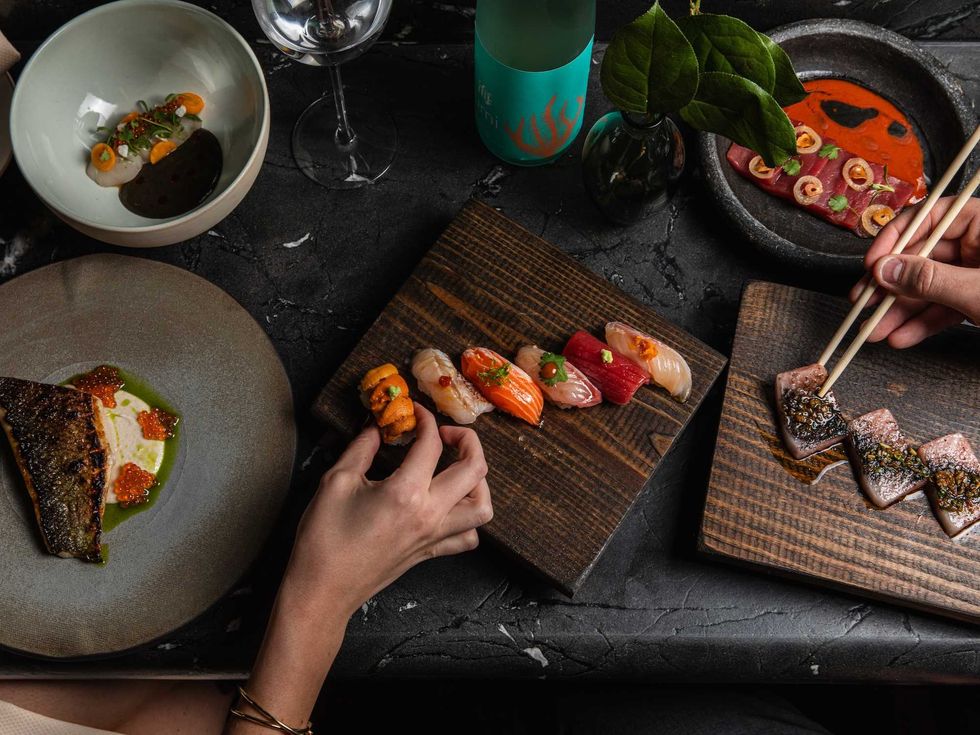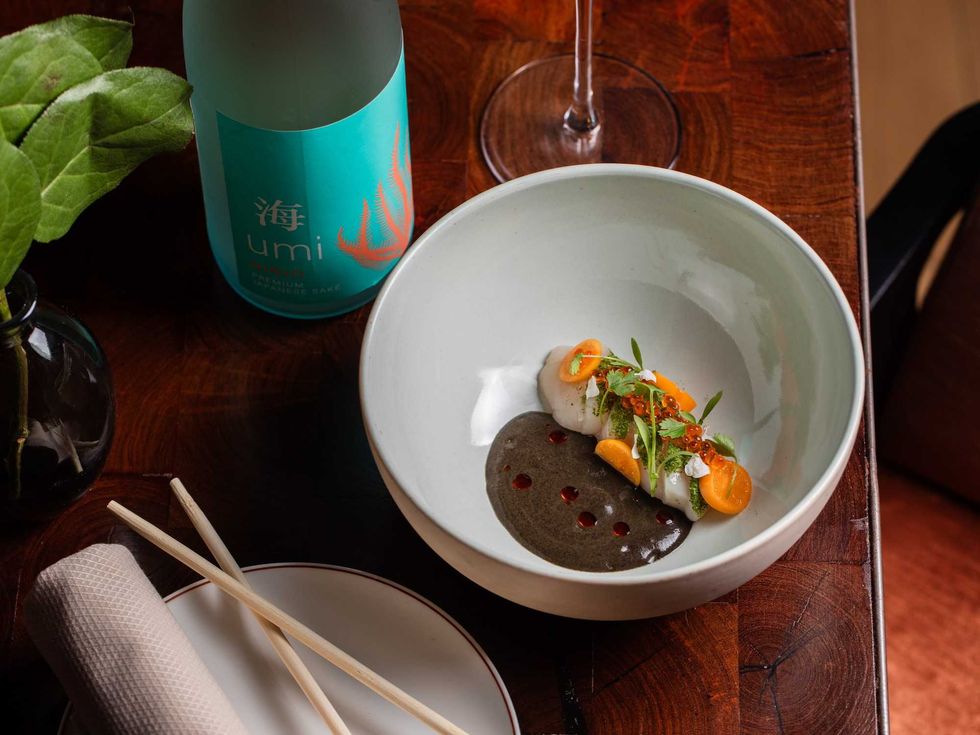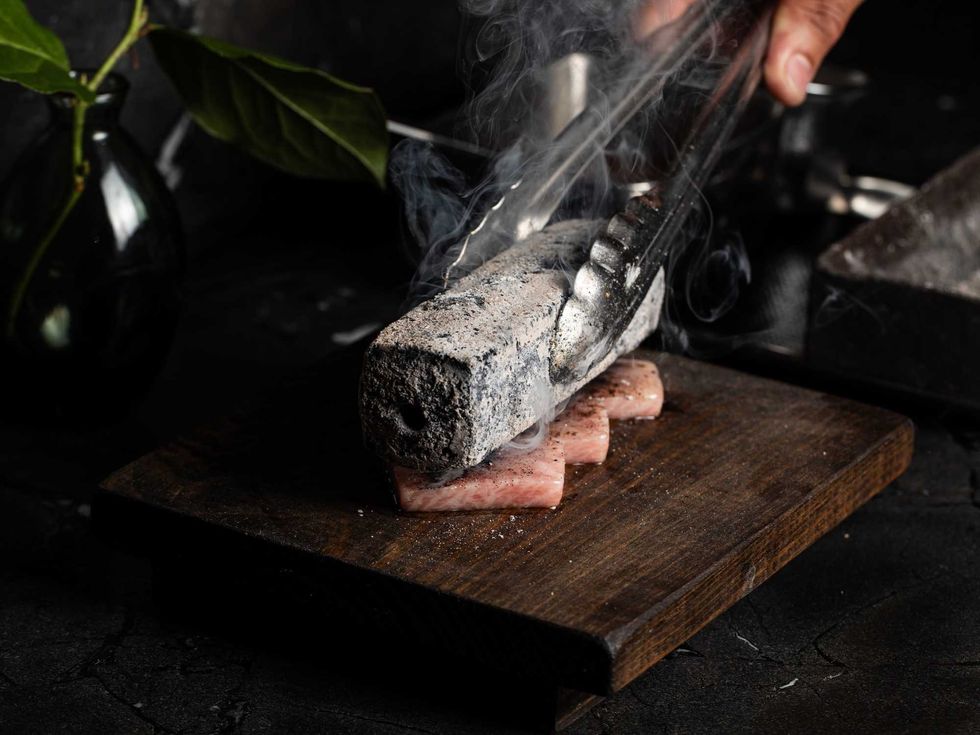First Taste
Don't judge Katsuya by its pretty cover — this is serious sushi
 Grilled corn is lightly charred and coated with a sweet butter glaze and asubtle touch of ginger.
Grilled corn is lightly charred and coated with a sweet butter glaze and asubtle touch of ginger. Katsuya master sushi chef Katsuya Uechi
Katsuya master sushi chef Katsuya Uechi Yellowtail sashimi with jalapenos
Yellowtail sashimi with jalapenos Crispy rice with spicy tuna
Crispy rice with spicy tuna Katsuya FreshPhoto by James Merrell
Katsuya FreshPhoto by James Merrell
All cliches aside, it's really tempting to judge a book by its cover. And yet all pretty people aren't dumb, all people in glasses aren't smart and every restaurant with a sleek design and a heavy bar scene isn't phoning in the food. Exhibit A: The new Katsuya by Starck, which opened in West Ave last week.
An LA favorite, Katsuya is known more for its celebrity clientele and its stunning design by A-lister Philippe Starck, so it's easy to imagine the Houston restaurant is all flash and no sizzle. It is not. Katsuya brings it on every level.
Walking in, once you get past the phalanx of modelesque hostesses in all black, its hard not to be impressed by the sleek beauty of the space.
Walking in, once you get past the phalanx of modelesque hostesses in all black, its hard not to be impressed by the sleek beauty of the space. There's the central bar, edged in rough chalk, the all-white tables and chairs in the dining room and the neon pink walls of the hallways that lead to the bathrooms and kitchens.
The minimalist aesthetic is tempered with occasional flashes of ornate style — pretty mirrors and chandeliers, gauzy curtains separating the private rooms — and some surprising flashes of ironic whimsy, like a gold-painted toy gun atop the central robata kitchen counter and the small tables set on gnomes in the lounge.
For starters
I started with a couple dishes dubbed Katsuya specialties, the yellowtail sashimi with jalepeño and the crispy rice with spicy tuna. The yellowtail was served in a dozen tiny bites, each with a bright flavor created by the interaction of the citrusy ponzo and the fresh fish. As far as spice goes, I could see the sliver of jalepeño but I certainly couldn't taste it, which was fine with me. As addictive as popcorn (but, you know, slimier), I was immediately impressed.
The crispy rice with tuna was more of a clunker. The thick square of rice was sweet but surprisingly heavy, and the spicy tuna didn't really wow me in either flavor or texture.
This was the moment I had to let go of any preconceptions that to enjoy sushi it has to have some grounding in authentic Japanese tradition.
Much better was the baked crab handroll. This was the moment I had to let go of any preconceptions that to enjoy sushi it has to have some grounding in authentic Japanese tradition. The handroll was the size of a large eggroll — another Americanized favorite — plump with sweet, baked crab, rice, a light touch of "signature sauce" that I couldn't quite place and held together by a thin but durable soy paper. It had a sweet fattiness that didn't seem Asian at all, but it was just so tasty.
I thought the Katsuya ceviche might be a nod to more Texan flavors, but despite the menu promising a citrus ponzu sauce, there was nothing remotely South American about it. (When it comes to mixing citrus with sushi, Uchi still stands alone.) It was basically just a mound of fresh sashimi, which is hard to complain about too much, even if it was a failure by the definition of the dish.
I have a weakness for unagi, so while I didn't plan to order any of the typical rolls — rainbow, spider, California, etc. — I went for the signture Sunset Roll, made of freshwater eel, cucumber and avocado. The result were huge rolls — the avocado isn't in the center but sliced thick and wrapped around the roll. Both the slight crunch of the cucumber and the unagi flavor was lost in the overwhelming richness and texture of the avocado — not bad, but unbalanced.
A side of corn
My waiter made several mentions of the robata grill, which heats to 1,200 degrees, searing all food that touches it in seconds. To see what all the fuss was about, I ordered a side of corn.
Corn is about the last thing I would ever expect to find, much less order, at a sushi restaurant, but it was actually a great example of what the grill could do. Lightly charred, the kernels were plump and juicy, coated with a sweet butter glaze and a subtle touch of ginger. One point for the grill.
My waiter made several mentions of the robata grill, which heats to 1,200 degrees, searing all food that touches it in seconds. To see what all the fuss was about, I ordered a side of corn.
Maybe the most impressive dish came from the Katsuya kitchens, though. The baked black cod was served on the banana leaf that it appeared to bake inside, cooked tender and flaky. The dish didn't seem to have any trace of moisture or sauce, but a sweet miso marinade infused every bite with incredible flavor.
Chef Katsuya Uechi told me on his first visit to Houston that he attributes his success to his ability to shape his Japanese cuisine to an American palate. Based on what I tried, that means a few dishes are sweeter and heavier than I'm used to, but whether or not you find that a good thing, there's plenty to like on the menu here.
In ambition Katsuya is certainly not an Uchi or a Kata Robata. But what Katsuya does, it does very, very well.








